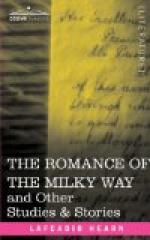There are many hundreds of poems in the three volumes of the Ky[=o]ka Hyaku-Monogatari; but the number of the ghosts and goblins falls short of the one hundred suggested by the title. There are just ninety-five. I could not expect to interest my readers in the whole of this goblinry, and my selection includes less than one seventh of the subjects. The Faceless Babe, The Long-Tongued Maiden, The Three-Eyed Monk, The Pillow-Mover, The Thousand Heads, The Acolyte-with-the-Lantern, The Stone-that-Cries-in-the-Night, The Goblin-Heron, The Goblin-Wind, The Dragon-Lights, and The Mountain-Nurse, did not much impress me. I omitted ky[=o]ka dealing with fancies too gruesome for Western nerves,—such as that of the Obum[’e]dori,—also those treating of merely local tradition. The subjects chosen represent national rather than provincial folklore,—old beliefs (mostly of Chinese origin) once prevalent throughout the country, and often referred to in its popular literature.
I. KITSUN[’E]-BI
The Will-o’-the-wisp is called kitsun[’e]-bi ("fox-fire"), because the goblin-fox was formerly supposed to create it. In old Japanese pictures it is represented as a tongue of pale red flame, hovering in darkness, and shedding no radiance upon the surfaces over which it glides.
To understand some of the following ky[=o]ka on the subject, the reader should know that certain superstitions about the magical power of the fox have given rise to several queer folk-sayings,—one of which relates to marrying a stranger. Formerly a good citizen was expected to marry within his own community, not outside of it; and the man who dared to ignore traditional custom in this regard would have found it difficult to appease the communal indignation. Even to-day the villager who, after a long absence from his birthplace, returns with a strange bride, is likely to hear unpleasant things said,—such as: “Wakaranai-mono we hippat[’e]-kita!... Doko no uma no hon[’e] da ka?” ("Goodness knows what kind of a thing he has dragged here after him! Where did he pick up that old horse-bone?”) The expression uma no hon[’e], “old horse-bone,” requires explanation.
A goblin-fox has the power to assume many shapes; but, for the purpose of deceiving men, he usually takes the form of a pretty woman. When he wants to create a charming phantom of this kind, he picks up an old horse-bone or cow-bone, and holds it in his mouth. Presently the bone becomes luminous; and the figure of a woman defines about it,—the figure of a courtesan or singing-girl.... So the village query about the man who marries a strange wife, “What old horse-bone has he picked up?” signifies really, “What wanton has bewitched him?” It further implies the suspicion that the stranger may be of outcast blood: a certain class of women of pleasure having been chiefly recruited, from ancient time, among the daughters of [’E]ta and other pariah-people.




